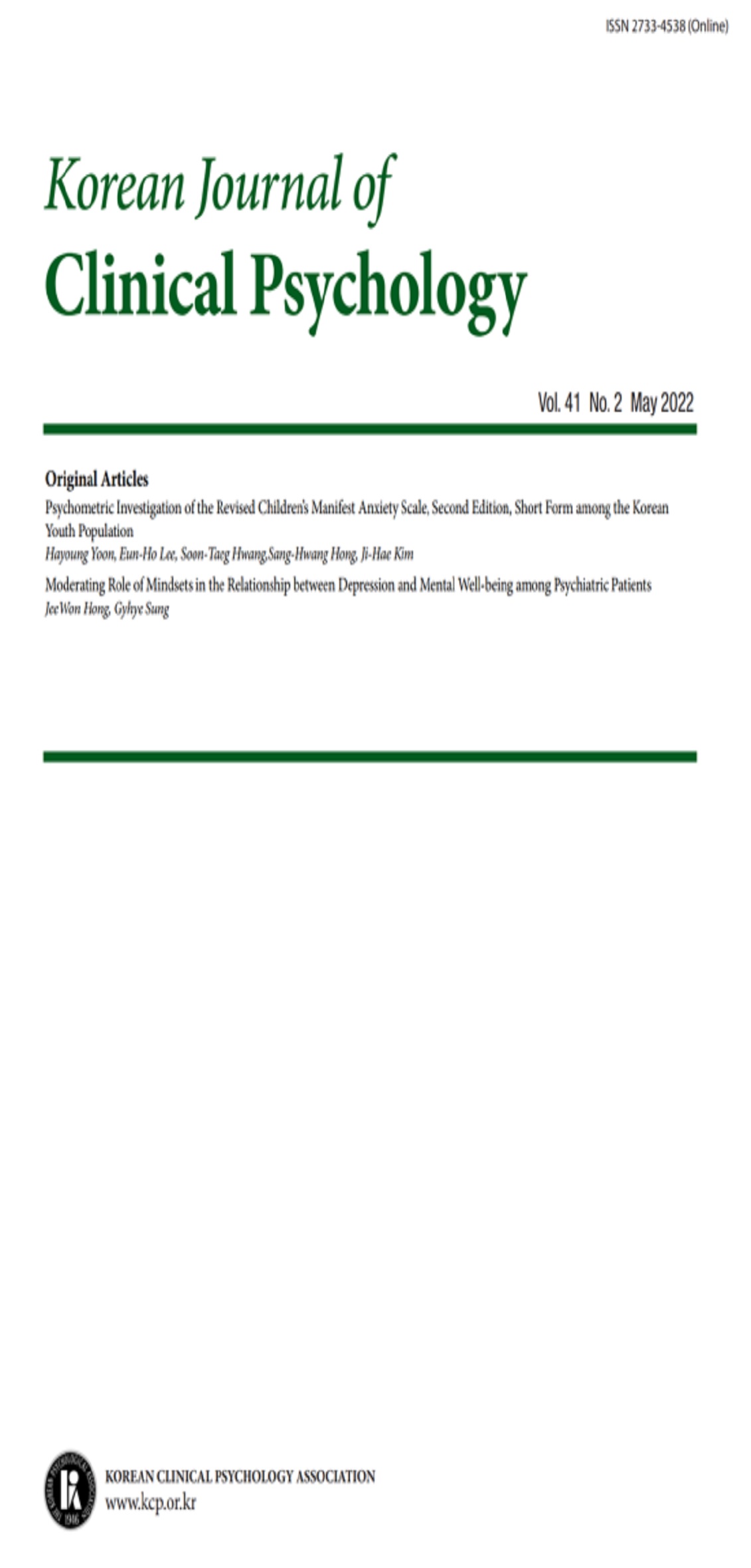open access
메뉴
open access
메뉴 E-ISSN : 2733-4538
E-ISSN : 2733-4538
본 연구에서는 모사실험 설계를 통해 K-WAIS-IV에서 경도 뇌손상 집단과 사병 집단을 변별할 수 있는 신경인지적 손상의 사병변별지표를 만들고자 하였다. 이를 위해 통제집단, 경도 뇌손상 집단, 세련된 사병모사 집단, 순박한 사병모사 집단의 K-WAIS-IV 결과를 분석하였다. 사병모사 집단을 변별할 수 있는 판별함수식을 산출하기 위해 K-WAIS-IV의 10개 핵심소검사를 독립변인, 집단을 종속변인으로 한 단계적 판별분석을 실시하였다. 산출된 판별함수식에 대해 특이도 .95 이상에서의 절단점을 산출하였다. 절단점에서의 민감도, 특이도, 정적 예언검증력, 부적 예언검증력, 정확분류율을 분석하기 위해 ROC 분석을 사용하였다. 분석결과 판별함수에 포함되는 소검사는 숫자(DS), 어휘(VC), 퍼즐(VP), 기호쓰기(CD)였다. 네 집단을 가장 잘 변별해주는 소검사는 숫자(DS)였다. 본 연구에서 산출된 판별함수식으로 볼 때 어휘(VC) 수행에 비해 숫자(DS), 퍼즐(VP), 기호쓰기(CD) 수행이 낮을 경우 사병의 가능성이 높은 것으로 시사되었다. 본 연구는 임상 현장에서 일반적으로 사용되고 있는 K-WAIS-IV에서 신경인지적 손상의 사병변별지표를 구성하였다는 것과 국내 자료를 기반으로 분석하였다는 데 의의가 있다.
The purpose of this study was to construct a malingering discrimination indicator on K-WAIS-IV by experimental simulation design. This study included 4 groups; control group, clinical group (mild TBI), sophisticated malingering simulation group, and naive malingering simulation group. Data from 154 participants were analyzed using stepwise discrimination analysis setting K-WAIS-IV 10 core subtests as IV, 4 groups as DV. Then the cutoff score of discriminant function was calculated in controlling specificity as 95% using ROC analysis. Sensitivity, positive predictive power, negative predictive power, and classification accuracy were also calculated at the cutoff score. The results are follows; Digit span, Coding, Vocabulary, and Visual puzzle showed significant variances for 4 -group discrimination. Digit span subtest had the largest discrimination effect. The results suggest that the lower performances on Digit span, Coding, and Visual puzzle comparing on Vocabulary the higher malingering possibility. The purpose of this study is to construct, Korea based data, malingering discrimination indicators of K-WAIS-IV frequently used in Korea.
고승희 (2009). 레이 15-항목 기억검사(Rey 15-Item Memory Test)의 사병변별지표개발 및 타당화 연구. 가톨릭대학교 대학원 박사학위 논문.
고승희, 이영호, 김석주, 임선영 (2008). 레이복합도형검사(Rey Complex Figure Test)의 사병변별지표에 대한 연구. 한국심리학회지:임상, 27, 653-667.
김홍근 (2003). K-사병진단검사 해설서(KMDT, K-Malingering Diagnostic Test). 대구: 도서출판 신경심리.
박병관 (2003). 한국판 벤튼신경심리검사의 타당화 연구. 고려대학교 대학원 박사학위 논문.
박찬량 (1997). 교통사고 피해자의 임상심리 평가에 대한 제언. 한국심리학회: 하계학술대회지. 1-12.
황순택, 김지혜, 박광배, 최진영, 홍상황 (2012). K-WAIS-IV. 대구. 한국심리주식회사.
Bagby, R. M., Rogers, R., Nicholson, R. A., Buis, T., Seeman, M. V., & Rector, N. A. (1997). Effectiveness of the MMPI–2 validity indicators in the detection of defensive responding in clinical and nonclinical samples. Psychological Assessment, 9(4), 406.
Bush, S. S., Ruff, R. M., Tröster, A. I., Barth, J. T., Koffler, S. P., Pliskin, N. H., ... & Silver, C. H. (2005). Symptom validity assessment:Practice issues and medical necessity: NAN Policy & Planning Committee. Archives of Clinical Neuropsychology, 20(4), 419-426.
Cato, M. A., Brewster, J., Ryan, T., & Giuliano, A. J. (2002). Coaching and the ability to simulate mild traumatic brain injury symptoms. The Clinical Neuropsychologist, 16(4), 524-535.
Coleman, R. D., Rapport, L. J., Millis, S. R., Ricker, J. H., & Farchione, T. J. (1998). Effects of coaching on detection of malingering on the California Verbal Learning Test. Journal of Clinical and Experimental Neuropsychology, 20(2), 201-210.
Curtis, K. L., Greve, K. W., & Bianchini, K. J.(2009). The Wechsler Adult Intelligence Scale-III and Malingering in Traumatic Brain Injury: Classification Accuracy in Known Groups. Assessment, 16(4), 401-414.
Etherton, J. L., Bianchini, K. J., Ciota, M. A., Heinly, M. T., & Greve, K. W. (2006). Pain, malingering and the WAIS-III working memory index. The Spine Journal, 6(1), 61-71.
Etherton, J. L., Bianchini, K. J., Heinly, M. T., & Greve, K. W. (2006). Pain, malingering, and performance on the WAIS-III Processing Speed Index. Journal of Clinical and Experimental Neuropsychology, 28(7), 1218-1237.
Greve, K. W., Bianchini, K. J., Mathias, C. W., Houston, R. J., & Crouch, J. A. (2003). Detecting malingered performance on the Wechsler Adult Intelligence Scale: Validation of Mittenberg’s approach in traumatic brain injury. Archives of Clinical Neuropsychology, 18(3), 245-260.
Guilmette, T. J., Faust, D., Hart, K., & Arkes, H. R. (1990). A national survey of psychologists who offer neuropsychological services. Archives of Clinical Neuropsychology, 5(4), 373-392.
Heinly, M. T., Greve, K. W., Bianchini, K. J., Love, J. M., & Brennan, A. (2005). WAIS Digit Span-Based Indicators of Malingering Neurocognitive Dysfunction: Classification Accuracy in Traumatic Brain Injury. Assessment, 12(4), 429-444.
Iverson, G. L., & Tulsky, D. S. (2003). Detecting malingering on the WAIS-III: Unusual Digit Span performance patterns in the normal population and in clinical groups. Archives of Clinical Neuropsychology, 18(1), 1-9.
Jasinski, L. J., Berry, D. T., Shandera, A. L., & Clark, J. A. (2011). Use of the Wechsler Adult Intelligence Scale Digit Span subtest for malingering detection: A meta-analytic review. Journal of Clinical and Experimental Neuropsychology, 33(3), 300-314.
Mittenberg, W., Theroux, S., Zielinski, R., & Heilbronner, R. L. (1995). Identification of malingered head injury on the Wechsler Adult Intelligence Scale.Revised. Professional Psychology: Research and Practice, 26(5), 491.
Robert, J. S., Bradley, N. A., Lauren, L. D., Brigid, W., Percival, H. P., & Linas, A. B.(2013). WAIS-IV Reliable Digit Span is no More Accurate Than Age Corrected Scaled Score as an Indicator of Invalid Performance in a Veteran Sample Undergoing Evaluation for mTBI. The Clinical Neuropsychology, 27(8), 1362-1372,
Rogers, R. (1997). Clinical assessment of malingering and deception (2nd ed.). New York: The Guilford Press.
Schoenberg, M. R., Dorr, D., & Morgan, C. D.(2003). The ability of the Millon Clinical Multiaxial Inventory-to detect malingering. Psychological Assessment, 15(2), 198.
Young, J. C., Sawyer, R. J., Roper, B. L., & Baughman, B. C. (2012). Expansion and re-examination of Digit Span effort indices on the WAIS-IV. The Clinical Neuropsychologist, 26(1), 147-159.
Wechsler, D. (2008). Wechsler Adult Intelligence Scale .Fourth Edition: Technical and interpretive manual. San Antonio, TX: Pearson.
